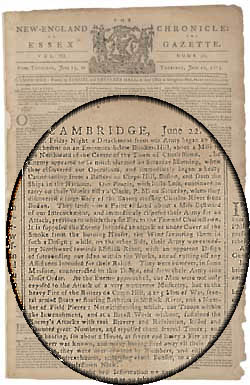Collections Online
"Cambridge, June 22. Last Friday Night a Detachment from our Army ..."
To order an image, navigate to the full
display and click "request this image"
on the blue toolbar.
-
Choose an alternate description of this item written for these projects:
- Main description
[ This description is from the project: Coming of the American Revolution ]
This newspaper article recounts significant events relating to the Battle of Bunker Hill, the fact that the provincial army dug an intrenchment "below Bunker Hill" (on Breed's Hill), the bombardment of the American's position by the British troops, the intense ground attack of British soldiers on the redoubt that was bravely defended by the Patriots for approximately two hours and the burning of Charlestown.
"Bravery and Resolution"
The "Bravery of the King's Troops" praised in the previous broadside is matched by accounts of equal "Bravery and Resolution" on the colonial side. Here a newspaper story from a different perspective recounts the cannonading of the American position in Charlestown from British guns on Copp's Hill in Boston's North End -- across the Charles River -- and the military actions that follow. The newspaper article contains a letter from a resident of Hingham -- a town south of Boston -- who has just returned from that city. It contains another report from an unidentified source in Chelsea -- just north of Charlestown -- and an erroneous claim that either General Howe or General Burgoyne has been killed in action.
To examine all four pages of this newspaper, please see the online display of The New-England Chronicle or the Essex Gazette, 15-22 June 1775.
Questions to Consider
1. What sources of evidence did the newspaper article employ? What were/are the advantages and disadvantages of each to the newspaper publishers? The intended audience? Readers today?
2. What lessons can we learn from this broadside about the use of sources, evidence based on hearsay, the spread of propaganda and the choice of words?
Further Exploration
3. The numbers of British troops involved is exaggerated in this newspaper article: historians have determined the figure to be closer to 2,000 grenadiers and light infantrymen against about 1,500 Americans to start (though there were less than half that number of Americans defending the fortifications at the end). The Hingham correspondent's figure of close to a thousand British troops killed or wounded is more accurate. American casualties numbered about half that. What accounts for the discrepancies? Would the same errors occur today? Why or why not?

